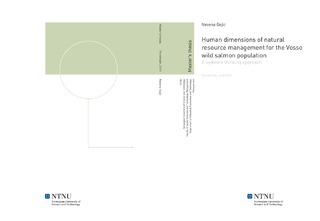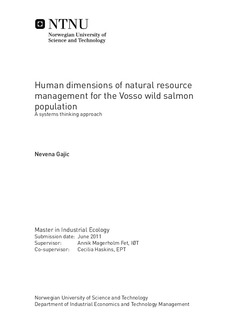| dc.description.abstract | Vosso, the second-largest watershed in Norway, was considered special as it produced some of the biggest salmon in the country. This salmon had economic, cultural as well as ecological importance. Due to its diversity, it was regarded a unique biological resource. Yet in the late 1980s the stock collapsed, quite abruptly and unexpected. This triggered a large-scale scientific research and eventually led to a rescue project to restore the wild Vosso salmon. The goal of this thesis was to explore the fundamental questions about the impact of human activity on nature and the conflicts of interest that exist within the management for the restoration of the wild salmon population in Vosso. The study aimed to answer the following question: “How does the strategy of the salmon restoration project in Vosso address the human dimensions for the restoration of the wild Vosso salmon population on a short and long term?” A systems approach was used for data collection and analysis. According to Checkland’s Soft Systems Methodology, the researcher first started with an examination of the background of the problem. The second step was to examine systems thinking about the situation. This step was operationalized with help of interviews, a questionnaire, content analyses and a discourse analysis. The third step of SSM required the development of a common understanding of the change and the change processes needed among the stakeholders involved in the rescue project. The strategy of the salmon restoration project in Vosso is mostly directed towards finding the causes for the decline of the Vosso salmon population. The measures taken to restore the salmon are primarily centered on producing salmon and treating sea lice. In the short term, this may lead to an increase of salmons in the river. But, if the sources of salmon threats are not eliminated, the survival of the salmon stock will be at risk, and the goal of reaching a sustainable salmon stock that reproduces naturally will be a challenging one. The inclusion of human dimensions in the rescue project is based on the involvement of people with different world views, neglecting differences in interest and centering on achieving the same objective: a wild salmon population that is able to reproduce naturally. However, salmon management in Vosso disregards long-term human dimensions: those human values embedded in institutions and passed on from generation to generation. For reaching sustainable salmon stocks, it is not only important to involve stakeholders with different values in salmon management, it is also crucial to understand the environmental discourses that trigger these values. This understanding needs to occur at all levels of management that influence the outcome of the salmon restoration project in Vosso. This study has shown that the salmon restoration management is trying to achieve sustainability, while employing a problem-solving discourse of administrative rationalism. For the achievement of a sustainable salmon population, the prevailing discourse of administrative rationalism in salmon management needs to make room for the discourse of sustainability. | nb_NO |

